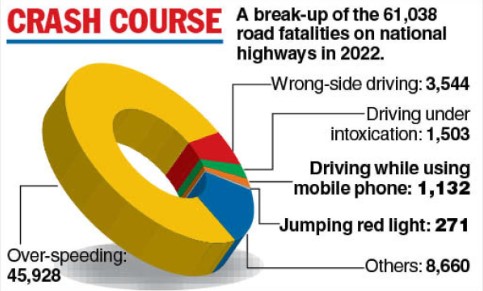Mobile phone use while driving causes four times higher fatalities on Indian highways than red light jumps, researchers have said in a study that has flagged concerns about weak enforcement of laws and high tolerance for risky behaviour.
The study on road safety legislation and traffic fatalities has suggested that driving on the wrong side of the road, driving under intoxication, and driving using mobile phones collectively contribute to nearly 10 per cent of deaths on India’s highways.
Over-speeding accounts for 75 per cent of the fatalities on national highways, the researchers from the Indian Institute of Technology (IIT), New Delhi, said, presenting their study at the 15th World Congress on Injury Prevention and Safety Promotion in the national capital on Tuesday.
“India has comprehensive road safety laws, but enforcement levels vary,” said Deepty Jain, assistant professor at the Transportation Research and Injury Prevention Centre at IIT Delhi and a co-author of the study.
“Anecdotal evidence points to weak enforcement and high acceptance of risky behaviour.”
The study, citing the latest available accident statistics from the Union road transport and highways ministry, said red light jumps led to 271 fatalities on national highways during 2022, while mobile phone use caused 1,132 deaths, a count 4.1 times higher. During 2021 too, mobile phone use caused 1,040 road fatalities, 4.8 times higher than 222 deaths attributed to jumping red lights.

Jain and her colleague Girish Agrawal and research scholar Manoj Kumar analysed road safety laws and enforcement patterns in India, Australia, Brazil, Canada and Thailand and found distinct patterns in specific countries.
In Canada, for instance, they noted “strong enforcement, low violation rates and high social disapproval of risky behaviour”.
In India, the researchers said, “inconsistent enforcement leads to high accident rates”.
Legislation, for instance, mandates the use of helmets by all two-wheeler riders and seat belts by four-wheeler riders nationwide. But helmet-less two-wheeler riders accounted for some 50,000 fatalities on the nation’s highways during 2022, 71 per cent among drivers and 29 per cent among pillion riders, the researchers said, drawing on the ministry’s data. Another 16,000 people who died were not wearing seat belts — 50.2 per cent drivers and 49.8 per cent passengers.
After over-speeding, driving on the wrong side of the road was the second leading cause of accident fatalities on national highways, accounting for 3,544 ( 5.8 per cent) of the 61,038 deaths during 2022. Driving under intoxication contributed to 1,503 (2.5 per cent) of the deaths.
The weak enforcement against the backdrop of such high-risk behaviour on roads calls for what the IIT researchers have described as “cultural shifts” to improve enforcement and change public behaviour.
But a health expert at the World Safety Conference cautioned that efforts at bringing about behaviour change through enforcement canbe challenging.
“We’ve been doing just this for many years, but it is becoming more and more evident that just trying to change human behaviour isn’t going to be enough,” said Jagnoor Jagnoor, a senior research fellow and injury epidemiologist at The George Institute for Global Health, a research think-tank.
“While those efforts must continue, we must also focus on creating enabling environments that means safer roads, safer vehicles — and not just safer four-wheelers,” Jagnoor told The Telegraph. “But four-wheeler occupants are relatively protected. Far more needs to be done to protect our most vulnerable road users which are pedestrians, motorised two-wheeler riders and cyclists.”
The road transport ministry’s 2023-24 annual report has documented 168,000 road accident fatalities during 2022, an increase from 153,000 fatalities during 2021.
A World Health Organisation report on road safety in the southeast Asia region released at the conference has estimated that two-wheeler riders made up 45 per cent of fatalities on Indian roads during 2021, followed by pedestrians (18 per cent) and cyclists (3 per cent).










